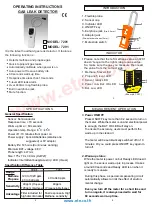
Identifying Alarms From Junk Detectors
Here are a few clues for spotting offending detectors.
You may get a brief K warning just as you meet an
oncoming car. Or a lingering K, nearly constant strength,
as you move with traffic. Big hint: a direction change on
the Radar Locator as you pass another car. Look for a
detector in the windshield. But stay alert until you know
for sure. See page 16 for what “Dee-Dah-Do” tone means.
•
Ka band:
Watch out! Most of the new-tech radars
operate on Ka. Expect some contamination from cheapie
detectors, just as with K (clues above also apply to Ka).
Do not dismiss Ka alerts until you’ve positively identified
the source.
How To Identify Bogeys
Look first at the Radar Locator. If it points to the side, the
bogey is non-threatening — radar can’t get you from the
side. If the Locator points ahead or behind, try for visual
identification. And when the Locator changes from Ahead
to Beside and then Behind, you can be sure the bogey is
safely behind you.
Check the Bogey Counter. Because many non-radar devices
occur in multiples. For example, most microwave door
sensors have at least two transmitters (for In and Out). Often
such an installation will have multiple doors too, so there
will be many transmitters. When you see two or more
on the Bogey Counter, and particularly when you see it
counting up quickly to four or more, you’ve likely found
a nest of door sensors.
Burglar-alarm microwave sensors are often multiples too,
because a single transmitter is not enough to safeguard an
entire building. But microwaves from alarms are less likely
to leak out of buildings. So alarms may appear singly or in
low multiples.
Single bogeys must be regarded as threats until you see
them or put them safely behind you.
Remember, too, that radar beams are easily reflected.
Buildings, overhead signs and passing traffic are all
good reflectors. When you have a strong signal from one
direction, don’t be surprised if the Radar Locator shows
brief flickers from another direction also as you drive
by reflectors.
And never forget that a brief alert, acting alone, may be
Instant-on radar zapping other traffic.
Finding Radar
On-the-road situations
Valentine One gives you far more information about radar
than any radar detector. Still, to achieve the best defense,
you must interpret this information correctly. The following
examples will help you get maximum protection.
Situation 1:
You are driving toward a radar aimed at you.
Your Warning:
The Ahead arrow will glow. The Bogey
Counter will show 1. You’ll hear a slow Beep for X band or
Brap for other radars. As you come close to the radar, the
Beeps (or Braps) will become more frequent until they
merge into a continuous tone. By this time you should see
the radar.
The Beside arrow and then the Behind arrow will glow as
you pass the radar.
In this situation, moving radar and stationary radar will give
the same alert, except the Beep rate will increase faster with
moving radar because the closing speed is greater.
Situation 2:
You’re driving on a hilly road. Radar is
waiting over the next hill.
Your Warning:
Well before you reach the hilltop, the
Ahead arrow will glow. The Bogey Counter will show 1.
You’ll hear a slow Beep or Brap, and the rate will increase
very quickly as you near the hilltop. As soon as you can see
over the hill, you will probably spot the radar.
Situation 3:
You’re driving on a curvy road. Radar is
waiting around the next curve.
Your Warning:
The Ahead arrow will glow (because the
radar is forward, not to the side, of your car). The Bogey
Counter will show 1. You’ll hear a slow Beep or Brap, and
the rate will increase very quickly as you turn the corner.
You should see the radar as soon as you’re around the
corner.
6
7






































